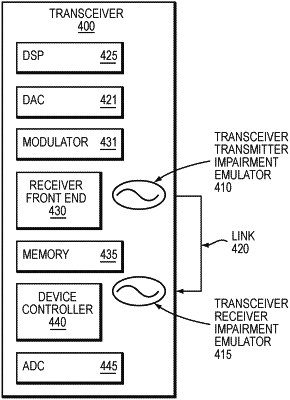| CPC H04B 17/0085 (2013.01) [H04B 17/0087 (2013.01); H04B 17/16 (2015.01); H04B 17/373 (2015.01); H04B 17/3912 (2015.01)] | 18 Claims |

|
1. A method comprising:
generating from an electrical signal, using a coherent optical transceiver comprising one or more components including a digital signal processor (DSP), control circuitry, and a photointegrated circuit (PIC), a light signal of a wavelength of light encoded with coherent optical data impaired with one or more emulated impairments; the coherent optical transceiver enabled to encode an electrical signal coherently on a wavelength of light and decode a coherent data encoded on a wavelength of light to an electrical signal; wherein the optical transceiver encodes the coherent data on the light signal; wherein the one or more emulated impairments are generated by the coherent optical transceiver to emulate impairments that occur during coherent optical communication without the need for specialized equipment; wherein the one or more emulated impairments are included in the light signal; wherein the one or more emulated impairments interfere with the ability to decode the encoded coherent data on the wavelength of light to enable testing of the ability of a coherent optical communication system to handle the emulated impairments; and
looping the light signal from an output of the coherent optical transceiver to an input of the coherent optical transceiver to self test tolerance of the optical transceiver to be able to remove the one or more emulated impairments in the light signal and recover the encoded data.
|